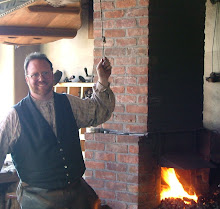The working end of the scythe is a blade of hand hammered steel between 18 and 33 inches long. It is used with a curving, sweeping motion rather than a chopping motion. On a traditional farm, a scythe gets several weeks of use each year. They get dull in use, and need to be sharpened up to several times an hour.
The farmer reaping hay or grain would have to stop work in the field when the scythe gets dull. They stop several times per hour, throughout the day, for sharpening. That would often be done using a whetstone -- a cut piece of naturally abrasive stone that is used to hone the edge.
The blade periodically needs more than honing with the stone. It needs to be peened out to thin the edge. This achieves several things. It fills in any nicks and dents in the blade. It re-profiles the edge to a nice thin taper. Finally, it prepares the blade for a final honing to achieve a razor edge.Here is Farmer Wayne peening the scythe blade in the blacksmith's shop.
Scythe anvil:
The days were long and full for a farmer during harvest season. Cutting hay and grain was always done on sunny days to allow the grain or hay to dry. Their work was long and hot. The days were long and hot for the blacksmiths as well as we repaired the farmer's scythes, mended wagon wheels, and reshod their horses. The reward from long hours of reaping was a barn full of hay and grain. A full barn provides the promise of prosperity in the comming year.
Winter Rye:







How is it that the blade fastens to the pole?
ReplyDeleteI had heard or read, that fiels workers always left the scythe hang outside over night during the harvest, as a bit of rust on the edge of the blade gave it better bite when reaping...TCA
ReplyDeleteI had not hear that advice! I know that hand hammering an edge was desired as it gave the cutting edge more "tooth" to cut the grain, but a light dusting of rust would probably do the same thing.
ReplyDeleteThanks for the antedote!
Steve
I was wondering if you knew of any online resources for actually making scythe blades. I have been scouring the web, but have had no luck so far.
ReplyDeleteI haven't heard of any smiths in the U.S. making scythe blades. I think there are still a few large forge shops in Italy, Germany, and Austria that still forge out scythe blades. They are done on a mechanical powerhammer with special drawing dies. There is one Musuem in Hagen, German that has a whole Scythe forging shop with working equipment. http://www.lwl.org/LWL/Kultur/LWL-Freilichtmuseum_Hagen/Englisch
ReplyDeleteThey still demonstrate how a scythe blade was made.
I have a nice scythe from the marugg company in Tennessee. I think they import their blades from Austria.
ReplyDeletehttp://www.themaruggcompany.com/
they are a pleasure to do business with (I have no connection with them)
I just bought a scythe from themaruggcompany.com and it is a treat to use! I edged out my yard in about the same time my neighbor takes with her weed whip, but I worked in blissful quiet!
ReplyDeletefarmers used to hang thier scythes outdoors to rust which left higher carbon to iron content. holds edge better
ReplyDeletehello, if anyone is a blacksmith or knows of a blacksmith. i am looking for them to make me two scythes. not any just scythe but a very detailed scythe that requires skill. please contact me faubelk@yahoo.com. they are gonna be like real props
ReplyDeleteFor some reason or another I've been having the urge to forge a scythe. Now that I have it heat treated I'm wondering if I should have left it unhardened after I read that peening the edge was part of the sharpening process. Is there a specific steel that is used for the blades?
ReplyDeleteI am trying to find someone to come to the Canandaigua, NY area to teach a class on using and sharpening a scythe for a small group of 10 or so individuals..... I've had no response from the Genesee Country Museum.... I know there are lots of videos out there, but I personally am a hands-on learner and I know others are as well... if you know of someone who could do that please contact me! rodandstafffarm@gmail.com
ReplyDelete